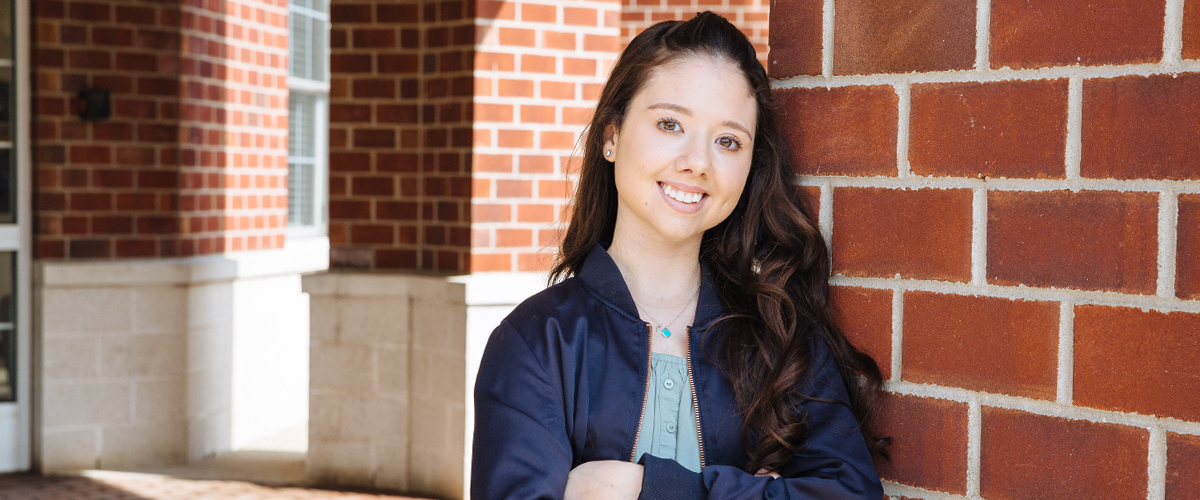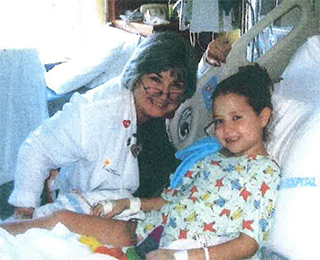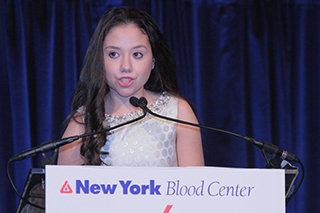Amazing Things: Lauren Shields
This college freshman survived a heart transplant at age 8. Today, she’s a leading advocate for organ donation in New York State.

When Lauren Shields, a normally energetic third grader in Stony Point, New York, complained in April 2008 of being tired every morning before school, her mother assumed she was just trying to get out of gym class.
“She’d ask if she could ‘accidentally’ forget her sneakers,” says Jeanne Shields, Lauren’s mom. “I said we all had to do things we didn’t like, and I made her put her sneakers on. I feel so badly about that now.”
That’s because what was going on was something no mother could have imagined: Lauren’s heart was failing, the result of a condition known as coxsackie myocarditis, an inflammation of the heart muscle typically caused by the body’s overactive immune response to a viral infection.
One day, as Lauren was getting ready for school, Jeanne noticed her daughter’s belly was distended. A visit to her pediatrician revealed only that Lauren was severely constipated; she was sent home with a stool softener. Soon afterward, Lauren’s face swelled, which led to a visit to the ER, where doctors discovered that her heart was enlarged, surrounded by fluid and working at 14 percent capacity. The 8-year-old was immediately admitted to a local hospital’s intensive care unit, where doctors inserted chest tubes to drain the fluid. A short time later — after researching the best place to treat her daughter — Jeanne moved Lauren to the pediatric cardiac ICU at NewYork-Presbyterian Morgan Stanley Children’s Hospital.
At that critical time, neither Lauren nor her mother could have imagined what would come next — that in the days, months, and years ahead, Lauren would be induced into a coma; require a heart transplant; suffer a stroke and a seizure; and turn her harrowing experience into a case for great change, transforming a regular kid into a force for lifesaving measures.
“Most of the time, I was really just sharing my story,” Lauren says of her eventual role as an advocate, working to register organ donors and helping to pass 2012’s Lauren’s Law, which requires people in New York State filling out forms at the Department of Motor Vehicles to either check yes or skip this question when asked if they want to be an organ donor. “I loved knowing that I was being a part of something that would last a long time, and it would be a law forever, and it would impact people for years and years to come.”

Lauren waits for a donor heart to become available at NewYork-Presbyterian Morgan Stanley Children’s Hospital.
Not Just Another Patient
Yet back in 2008, upon their arrival at NewYork-Presbyterian Morgan Stanley Children’s Hospital, both Lauren and Jeanne were scared of what lay ahead, but relieved to feel an immediate difference in the level of care they received.
“Everyone was very empathetic,” says Jeanne. “They communicated with Lauren. They really brought her into the process in terms of explaining things to her in a way that was not scary to her.”
Lauren was in the hospital for months, being treated with steroids to try to stabilize her immune system so her heart could recover.
When one has myocarditis, “the body actually starts attacking itself,” says Dr. Linda Addonizio, director of the Pediatric Heart Transplant Program at NewYork-Presbyterian Morgan Stanley Children’s Hospital, who began seeing Lauren in the hospital’s outpatient heart failure clinic. “She’d improve a bit, then get worse again. Myocarditis isn’t as rare as you might think. What’s rare is for people to get so incredibly sick, then not get better.”
On January 9, 2009, Lauren was in end-stage heart failure. To survive, she needed a heart transplant as soon as possible.
“As a parent, I’m good at mothering, but I didn’t have the skill set to deal with what was being thrown at her,” says Jeanne. “Everyone explained things to her in a way that didn’t frighten her. They didn’t just treat her like a little body in a bed.”
An Agonizing Wait
On February 2, 2009, Lauren was put on the United Network for Organ Sharing list for cardiac transplantation as a 1A priority candidate, meaning she needed a new heart urgently. Yet she still had an indefinite wait ahead. Back in 2009, there were 14,631 donors and a staggering 105,567 people on the waiting list for hearts and other organs.
As the days and weeks ticked by with no new heart available, Lauren grew sicker, and her other organs gradually shut down. She had to go on dialysis when her kidneys failed and undergo several exploratory surgeries due to internal bleeding.
“I was too tired to play, get out of bed, or even say a full sentence,” she recalls.
Meanwhile, Jeanne kept vigil in the hospital, sleeping in the window sill in Lauren’s room and trying not to let her worry show.
“If Lauren knew how worried I truly was, it would have frightened her,” says Jeanne. “I’ll never forget the day they were about to wheel Lauren in for surgery to place two ventricular assist devices to help her heart pump blood throughout her body. She said, ‘Mommy, I’m scared.’ I told her, ‘Look at me — do I look scared? If I’m scared, you can be scared. But if I’m not, you can’t be.’ As soon as Lauren was gone, I burst into tears.”
It was tough for Jeanne to be stoic when Lauren had to be intubated and kept totally anesthetized after the biventricular assist devices were placed.
“My chatty little girl wasn’t talking anymore,” says Jeanne, who began keeping an illustrated journal of all that was happening at the hospital — which nurses were taking care of Lauren, what was served for lunch and dinner — so she could tell Lauren everything when she woke up. “Lauren is very inquisitive. She’s always asking questions, and I knew she’d want to know everything.”

Lauren with Dr. Addonizio.
Jeanne couldn’t have known that this diary would one day inform Lauren’s activism, serving as a chronicle Lauren would draw from when sharing her story in public. At the time, in her journal, she just recorded Lauren’s day-to-day experiences. She also wrote about the moment everything changed.
“It was the middle of the night and Lauren had all these tubes in her, and I could see that there was blood in one of the tubes and that there was more and more of it,” she says. “It went from drip, drip to really coming out very quickly.”
Jeanne called in a doctor, who approved a blood transfusion and said Lauren would need more exploratory surgery to detect the source of the blood flow.
“There was doom in the air,” Jeanne recalls. “I felt hopeless.”
That is, until the next morning when Dr. Addonizio arrived, with a sea of people behind her spilling out into the hall. They had all come to hear Dr. Addonizio deliver the news that they had found a heart for Lauren.
“I was in disbelief,” says Jeanne. “I looked over at Lauren and wished so much that I could wake her up and tell her.”
Bumps in the Road
Lauren got her new heart on March 19, 2009. When Jeanne saw her being wheeled out of the elevator after the four-plus-hour surgery, she could tell right away that Lauren’s new heart was working.
“Her cheeks were pink, and, for the first time in so long, her skin was warm to the touch,” Jeanne recalls.
But because Lauren had been in a coma for two weeks, it took time for her to fully wake up. On the 11th day after surgery, she opened her eyes. The first thing she saw was her mother in her usual spot by the window in her hospital room, fast asleep.
“I wanted to wake her up so I could talk to her, but I couldn’t because of the breathing tube,” says Lauren. “But I wasn’t in pain — I was happy about that. And when my mom eventually woke up and came over, it was a very special moment.”
Lauren was weak, and her muscles had deteriorated while she was in the coma and confined to bed. Though her new heart was functioning well, with no signs of rejection, Lauren could barely hold her head up, much less sit in a backless chair or walk.
“Lauren is a perfect example of why we need more organ donation,” says Dr. Addonizio. “If we had gotten her a heart sooner, she wouldn’t have had to go on the ventricular assist devices, which can cause lots of complications over time.”
One serious problem was that in the initial weeks after the transplant, Lauren had problems with her strength and movement, followed by a seizure. Areas of her brain — referred to as ischemic areas — had been affected by her extreme heart failure and would need time to recover.
Now, faced with months of physical therapy, Lauren was not only struggling to relearn to walk but she was also grappling with her identity and, like any kid, craving some independence.
“I had to basically learn how to do everything again,” she says. “I couldn’t sit in a chair that didn’t have a back to it. I couldn’t stand. I couldn’t dress myself. I couldn’t do anything on my own. And that was really very frustrating for me.”

As an activist, Lauren shares her experience with others in order to raise awareness about the importance of organ donation.
Accidental Activist
Three months later, 9-year-old Lauren walked into fourth grade with just a cane to help her, and an aide trailing behind carrying her books. Because of the immunosuppressant drugs Lauren was taking to prevent her heart from being rejected — along with what Dr. Addonizio called a “cereal bowl’s worth” of medications, 16 in the morning, 16 at night — Lauren had to be extra careful about protecting herself from germs.
“At first I felt different from the other kids. I had to wear a mask,” she says.
Jeanne also made sure there was a bottle of hand sanitizer on every student’s desk, as Lauren was extremely susceptible to germs.
But soon enough, Lauren’s world returned to how she remembered it. She began participating in recess, seeing friends, even going to gym class without protest.
“The whole point of a heart transplant is not to put kids in a bubble, but to let them play sports, have pets, even climb mountains,” says Dr. Addonizio, who has childhood heart transplant patients who now run marathons, climb mountains, play competitive baseball, and are state champion gymnasts. There’s even one who lifts 350-pound weights.
“My doctors told me to do whatever felt comfortable, no restrictions,” says Lauren. “Because of my new heart, I was able to live like any 9-year-old.”
Months into her return to school, Lauren was asked to share her story on the local news, which led to a call from Donate Life America, an organ donation registry. They wanted to know if Lauren would talk about her transplant journey at a naturalization ceremony to encourage new citizens to become organ donors.
“I was only 10 and I was very scared, but I was also excited to talk about what I’d been through,” Lauren says.
It was at another such ceremony that Lauren met New York State Sen. David Carlucci.
“I didn’t even know what a senator was,” she recalls. Still, she introduced herself and told him that she wanted to help increase the number of organ donors in New York State, which lagged at the very bottom of the country in terms of registered donors.
To her surprise, Sen. Carlucci said he thought he could use her help with a new law, later inviting her to the state capital to tell her story to legislators. He hoped to change the wording of the organ donor question at DMVs throughout the state, starting with making it mandatory to answer.
Lauren and her mom made several trips to Albany, prepping in the car during the drive.
“She was a natural, and everything snowballed from there,” says Jeanne.
I loved knowing that I was being a part of something that would last a long time, and it would be a law forever, and it would impact people for years and years to come.
Lauren Shields
Soon, in addition to lobbying, Lauren was doing advocacy work for the American Heart Association and the New York Blood Center.
With Lauren’s help, Lauren’s Law was passed in 2012, requiring the DMV questionnaire change that would help save countless lives. In 2018, partly as a result of Lauren’s Law, there was a 50 percent increase in New York State residents saying yes to organ donation at the DMV , with 600,000 new people signing up to be donors.
These days, Lauren, now 18, is doing her advocacy work on campus, at Dominican College in Orangeburg, New York, where she is a freshman biology major.
“In October, I signed up more than 100 students to be donors for organ donor enrollment day,” she says.
Today, Lauren savors her hard-won independence, including her ability to go dancing with friends, or for a drive, now that she has her license. Her once formidable list of prescriptions is down to two anti-rejection drugs, a blood thinner, and medication to control her blood pressure.
And she is especially amazed when she confides in new college friends about what she has been through, and they tell her they had no idea.
“They don’t see me as someone with a heart transplant,” says Lauren. “They see me as a biology major juggling 18 credits and taking boxing classes at the gym.”
Yet Lauren’s journey has shaped her, and she can’t help continuing to give back because of it.
“I want to become a pediatric cardiologist,” she says. “I can’t wait for the day I can go up to a little kid who needs a heart transplant and tell her she’ll be OK, because look at me and at all the things I’ve been able to accomplish because of my transplant,” she says. “I know it will take a while to get there, but I’m working toward the time I can be that hope for someone, the way my doctors were for me.”
Learn more about how you can become an organ donor.
